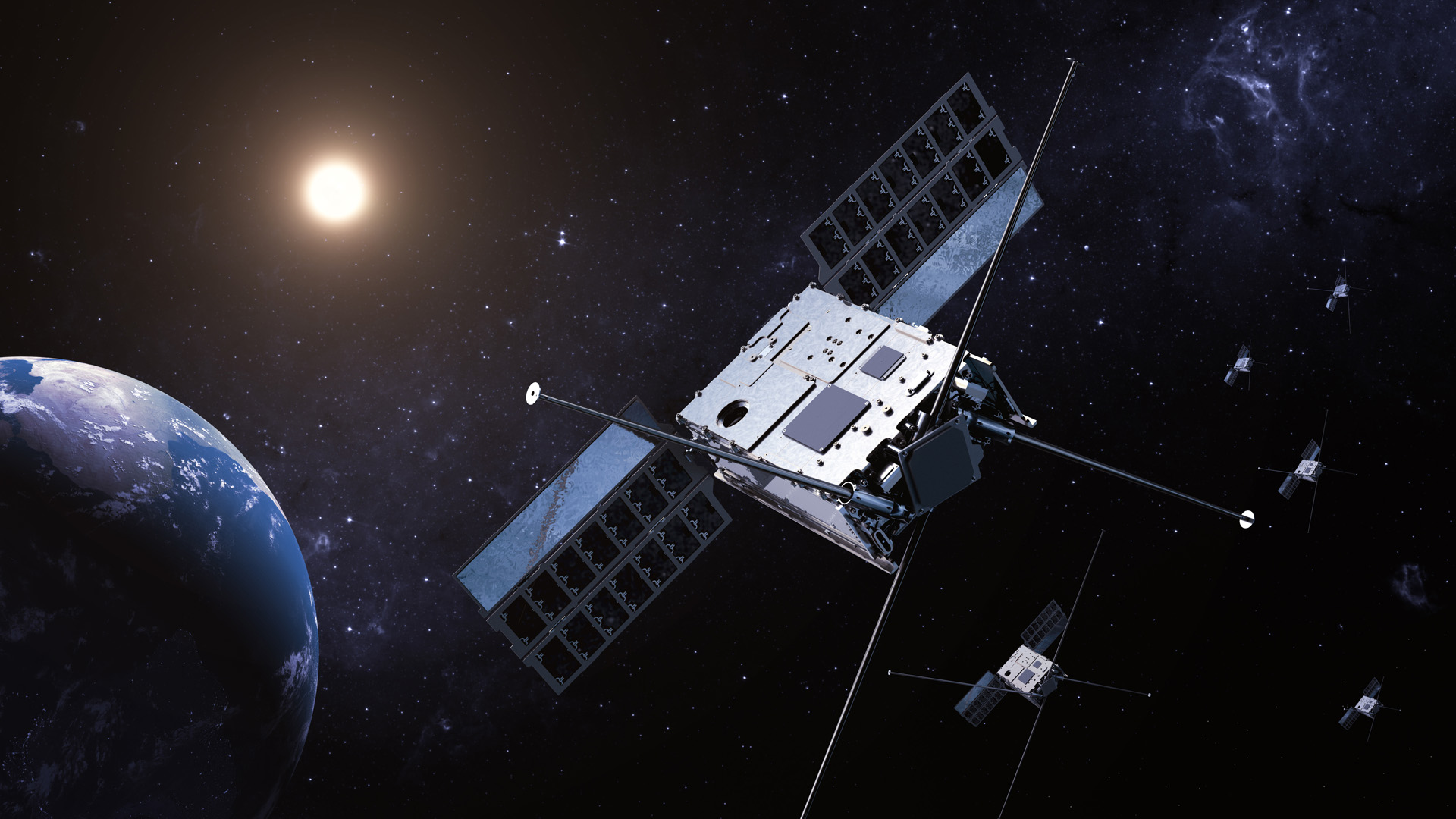
SunRISE
Mission Summary
Overview
 The Sun Radio Interferometer Space Experiment (SunRISE) mission is a low radio frequency interferometer in space to understand the nature of solar bursts. SunRISE uses a space-based array, composed of six CubeSats flying in supersynchronous geosynchronous Earth orbit (GEO) within 10 km of each other. This array will image the sun and give key information on particle acceleration mechanisms associated with coronal mass ejections (CMEs).
The Sun Radio Interferometer Space Experiment (SunRISE) mission is a low radio frequency interferometer in space to understand the nature of solar bursts. SunRISE uses a space-based array, composed of six CubeSats flying in supersynchronous geosynchronous Earth orbit (GEO) within 10 km of each other. This array will image the sun and give key information on particle acceleration mechanisms associated with coronal mass ejections (CMEs).
Science Objectives
The Sun is largely unknown to us, yet solar  flares that the sun produces have the potential to cause major problems on Earth. Periodic bursts of charged particles can interfere with GPS signals and even shut down entire power grids. The SunRISE mission’s goal is to utilize a well-established remote sensing technique with the satellite formation to create a long-baseline interferometer to discriminate competing hypotheses for the generation of Solar Energetic Particles (SEPs) and its relation to CMEs. One major scientific goal is to associate and correlate Type II radio emissions to said SEPs. Another goal is to reconstruct magnetic field lines associated with Type III radio burst, which helps discriminate competing hypotheses for the variable magnetic connection between active regions and the inner heliosphere. In short, this mission will aid understanding about how SEPs accelerate and the correlations between Type II radio bursts and the formation of CMEs.
flares that the sun produces have the potential to cause major problems on Earth. Periodic bursts of charged particles can interfere with GPS signals and even shut down entire power grids. The SunRISE mission’s goal is to utilize a well-established remote sensing technique with the satellite formation to create a long-baseline interferometer to discriminate competing hypotheses for the generation of Solar Energetic Particles (SEPs) and its relation to CMEs. One major scientific goal is to associate and correlate Type II radio emissions to said SEPs. Another goal is to reconstruct magnetic field lines associated with Type III radio burst, which helps discriminate competing hypotheses for the variable magnetic connection between active regions and the inner heliosphere. In short, this mission will aid understanding about how SEPs accelerate and the correlations between Type II radio bursts and the formation of CMEs.
Timeline
 NASA released an Announcement of Opportunity in 2016. Following this Justin Kasper (SunRISE’s Principal Investigator) and his team submitted their proposal for SunRISE. The mission was selected to begin the Phase A study in 2017 and is now in Phase B, which was initiated in June of 2020. Spacecraft are expected to launch no earlier than 2024.
NASA released an Announcement of Opportunity in 2016. Following this Justin Kasper (SunRISE’s Principal Investigator) and his team submitted their proposal for SunRISE. The mission was selected to begin the Phase A study in 2017 and is now in Phase B, which was initiated in June of 2020. Spacecraft are expected to launch no earlier than 2024.
The core science operations occur after launch during Phases D and E and are split into several smaller phases. Six satellites will be deployed from the host spacecraft, maneuvered into their constellation formation, and prepared for science operations. During Phase E, spacecraft will work in unison in repeated weekly operational patterns.
Technical Approach
SunRISE has three mission features which conduct aperture synthesis.  This process combines the observations of smaller antennas which reflect frequency coverage of a larger antenna. The position of the spacecraft does not need to be controlled as long as we know the position accuracy to be within 1 meter. Each individual spacecraft operate independently, and each spacecraft’s data is combined on the ground to form the SunRISE aperture synthesis. The spacecraft for SunRise will be designed by the Space Dynamic Laboratory of the Utah State University Research Foundation. The hardware and software used onboard SunRise has been used before in space. SunRise will integrate the components into a small satellite design which also incorporates the data and GNSS receiver, which is housed inside the science payload.
This process combines the observations of smaller antennas which reflect frequency coverage of a larger antenna. The position of the spacecraft does not need to be controlled as long as we know the position accuracy to be within 1 meter. Each individual spacecraft operate independently, and each spacecraft’s data is combined on the ground to form the SunRISE aperture synthesis. The spacecraft for SunRise will be designed by the Space Dynamic Laboratory of the Utah State University Research Foundation. The hardware and software used onboard SunRise has been used before in space. SunRise will integrate the components into a small satellite design which also incorporates the data and GNSS receiver, which is housed inside the science payload.
References
- Nasaspaceflight.com – Sunrise Mission to Study Giant Solar Particle Storms.” Nasaspaceflight.com, 15 March 2020, https://www.nasaspaceflight.com/2020/03/sunrise-mission-study-giant-solar-particle-storms/. Accessed 15 Aug. 2023.
- Tijerina, David. ‘The Texas Electric Grid Almost Collapsed in February. Here’s How It’s Prepping for the Next Crisis.’ Texas Monthly, 14 July 2021, https://www.texasmonthly.com/news-politics/texas-electric-grid-failure-warm-up/. Accessed 15 Aug. 2023.
